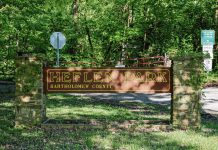They’re big and not pretty, and they’ve found a new home in Forest Park.
Dozens of turkey vultures are hanging out in the spring-bare tree branches in the neighborhoods north of North Christian Church near Hawthorne Drive.
“Strange animals. Useful, but ugly,” said Greg Littleton, Forest Park resident, about his new neighbors. Neighborhood residents have reported seeing as many as 40 vultures in the nearby trees.
Littleton regularly sees seven or eight of the distinctive birds in the trees around his yard. And they are hard to miss, he said.
[sc:text-divider text-divider-title=”Story continues below gallery” ]
At more than 2-feet tall, with a wingspan of up to 5½-feet across, turkey vultures are one of the largest nonaquatic birds in Indiana.
The Indiana Department of Natural Resources said turkey vultures can be distinguished from other large birds by their slow, soaring flight pattern, splayed, hand-like wing feathers and fleshy, bald heads.
In spite of their looks, the turkey vultures are not predatory, said Kathy Hershey, who operates Utopia Wildlife Rehabilitators near Hope. Turkey vultures will not attack pets or children unless their young are threatened, she said.
They are also protected by federal law, which prohibits killing or harming the birds, she said.
And there really are no good reasons to hurt a turkey vulture, Hershey said.
The species lives almost entirely on a diet of dead animals and rotting plants. Their digestive tract is one of the marvels of the animal universe, capable of filtering and digesting nearly all diseases, Hershey said.
Through the years, scientist have exposed turkey vultures to a host of deadly pathogens from cholera to anthrax, Hershey said. None can survive the bird’s belly.
Their presence in an area actually reduces the danger of disease by converting decaying meat into sanitized bird droppings, Hershey said.
Turkey vultures are also among the friendliest, least aggressive bird species in Indiana, she added.
Utopia is caring for a turkey vulture named Parker, rescued near Parkside Elementary School in Columbus. The bird caused a minor disruption after it decided to make a game of untying students’ shoes during recess on the playground.
That’s the most harmful type of behavior one can expect from a turkey vulture, she added. Even then, Parker had been separated from other vultures when he was young and become unusually comfortable around people, Hershey said.
In most cases, turkey vultures will simply fly away from approaching humans or pets, though they have been known to play with toys or loose objects left outside, Hershey said.
Vultures rarely roost during the daytime, she said. Lone turkey vultures often soar 30 to 40 miles per day in search of food before returning to a central gathering place in the early morning and late evening.
The birds probably chose the Forest Park area because it resembles conditions at a nearby ancestral roosting ground, which may have been disturbed by development in the area, Hershey said.
In spite of their strange appearance, turkey vultures are actually pretty good neighbors, Hershey said. They’re clean, absolutely quiet and keep to themselves, she said.
[sc:pullout-title pullout-title=”About turkey vultures” ][sc:pullout-text-begin]
Family: Considered a “New World” vulture — others in the category are the California condor, the King vulture and storks.
Where it gets its name: From its red bald head that resembles a male wild turkey. Turkey vultures have brownish black body feathers with silver showing when wings are spread.
Habitat: Cliffs, caves, trees, thickets and even abandoned buildings.
Food: Primarily feed on fresh carrion, from small to large mammals.
What do you call a group of vultures?: A group of turkey vultures is called a committee, venue or volt. In flight, a flock of vultures is a kettle, and when the birds are feeding together at a carcass, the group is called a wake.
Source: Audubon Society
[sc:pullout-text-end]




